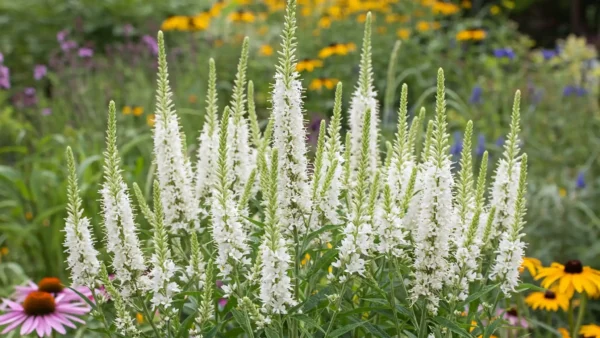Yorkshire-fog
Holcus lanatus, commonly known as Yorkshire Fog or Velvet Grass, is a perennial grass species that can add a unique texture and visual interest to gardens and meadows. It’s characterized by its soft, velvety appearance and the distinctive purplish tinge of its flower heads.
Plant Care
Sunlight
Yorkshire Fog thrives in partial shade to full sun. It can tolerate shade but may become leggy in low-light conditions.
Soil
This grass is adaptable to a variety of soil types but prefers well-draining, loamy soil. It can also tolerate slightly acidic to slightly alkaline soils.
Watering
Once established, Yorkshire Fog has moderate water requirements. Water consistently, keeping the soil evenly moist, but avoid waterlogged conditions.
Fertilization
While it doesn’t require heavy fertilization, an application of a balanced, slow-release fertilizer in early spring can promote healthy growth.
Pruning
Yorkshire Fog benefits from occasional pruning or mowing to maintain a neat appearance and prevent it from becoming too tall and leggy.
Propagation
Propagate Yorkshire Fog by dividing established clumps in early spring or early fall. You can also sow seeds in early spring.
Landscaping Use
Yorkshire Fog is often used in meadows, naturalistic landscapes, and cottage gardens to create a soft, informal appearance. It pairs well with wildflowers and other grasses.
Wildlife Habitat
The seeds of Yorkshire Fog are a food source for various birds, making it a valuable addition to wildlife-friendly gardens.
Disease and Pest Resistance
Yorkshire Fog is relatively resistant to common pests and diseases, but occasional monitoring is still recommended.
Maintenance Level
Low to moderate, depending on its intended use. In more formal gardens, it may require more maintenance to prevent self-seeding.
Drought Tolerance
It has moderate drought tolerance, but it prefers consistently moist soil.
Soil Improvement
Yorkshire Fog’s deep roots help improve soil structure over time.
Cultural Significance
Historically, it was used as a forage grass for livestock, especially in Yorkshire, England.
Edible Parts
While not typically consumed by humans, it’s a valuable forage grass for grazing animals.
Lifespan
Perennial, returning year after year.
Seed Dispersal
Yorkshire Fog produces seeds that can spread through the wind, making it a self-sustaining plant.
Companion Plants
Pair with wildflowers like oxeye daisies or yarrow for a naturalistic look.
Aesthetic Appeal
The soft, velvety texture of Yorkshire Fog adds a unique touch to garden designs.
Environmental Benefits
It provides habitat and food for wildlife and contributes to the biodiversity of a garden.
Table with basic info about Yorkshire-fog
| Aspect | Information |
|---|---|
| Scientific Name | Holcus lanatus |
| Common Names | Yorkshire Fog, Velvet Grass |
| Family | Poaceae (Grass Family) |
| Genus | Holcus |
| Soil Requirements | Well-draining, loamy soil |
| Soil pH Range | 5.0 – 7.0 |
| Best Soil Mix | Well-draining loam enriched with organic matter |
| Country of Origin | Native to Europe, but now found worldwide |
| Discovery Year | Not precisely documented |
| Flowering Time | Late spring to early summer |
| Watering Frequency | Moderate, keeping the soil evenly moist |
| Origin | Native to Europe, now widespread |
| Minimum Temperature | Tolerates temperatures down to -10°C (14°F) |
| Flower Color | Purple-tinged flower heads |
| Growth Habit | Perennial grass |
| Lifespan | Perennial |
| Light Requirements | Partial shade to full sun |
| Drought Tolerance | Moderate |
| Wildlife Attraction | Attracts birds with its seeds |
| Disease and Pest Resistance | Relatively resistant to common pests and diseases |
| Maintenance Level | Low to moderate, depending on usage |
| Uses | Ornamental grass, wildlife gardens, erosion control |
| Propagation Methods | Division in early spring or early fall, seed sowing |
| Companion Plants | Oxeye daisies, yarrow, low-growing sedums |
| Potential Weeds | Can become invasive in lawns if not managed |
| Soil Compaction Tolerance | High tolerance, suitable for soil improvement |
| Cultural Significance | Historically used as forage for livestock |
| Edible Parts | Valuable forage grass for grazing animals |









